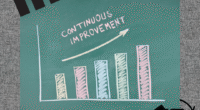For manufacturing managers, mastering Kaizen is essential to driving continuous improvement, improving efficiency, and fostering a culture of operational excellence. Kaizen, which means “change for the better,” emphasizes small, incremental improvements that accumulate over time to create significant organizational impact. This guide outlines practical strategies for managers to implement Kaizen effectively in manufacturing settings.
Understanding Kaizen in Manufacturing Management
Kaizen is not just a tool for frontline employees; it is a management philosophy. Managers play a crucial role in setting the tone, providing resources, and ensuring that continuous improvement initiatives align with business goals. By understanding Kaizen principles, managers can inspire their teams and guide meaningful changes throughout the production process.
Core Principles of Kaizen:
-
Continuous Improvement: Encourage ongoing, incremental enhancements rather than one-time fixes.
-
Employee Involvement: Engage workers at all levels to identify problems and suggest solutions.
-
Waste Elimination: Reduce unnecessary motion, defects, inventory, and waiting times.
-
Standardization: Implement consistent processes to maintain improvements and prevent backsliding.
Step 1: Assess Current Processes
Begin by evaluating existing workflows and identifying inefficiencies or bottlenecks. Tools like process mapping, value stream analysis, and performance metrics can help managers pinpoint areas with the highest potential for improvement. Accurate assessment ensures that Kaizen efforts target the most impactful areas.
Step 2: Set Clear Objectives
Define SMART goals (Specific, Measurable, Achievable, Relevant, Time-bound) for improvement initiatives. Examples include reducing machine downtime by 15%, increasing assembly line output by 10%, or decreasing production errors by 20%. Clear objectives provide focus and a benchmark for measuring success.
Step 3: Form and Empower a Kaizen Team
Managers should establish a cross-functional Kaizen team consisting of operators, supervisors, and engineers. This team drives improvement initiatives, encourages participation, and ensures that changes are practical and sustainable. Managers must empower the team by providing the necessary authority and resources.
Step 4: Implement Incremental Changes
Kaizen is all about small, continuous improvements. Examples include reorganizing workstations to improve ergonomics, streamlining communication between departments, or revising quality check procedures. Encourage trial-and-error approaches and adapt processes based on feedback and results.
Step 5: Monitor Performance and Refine Processes
Track results using key performance indicators (KPIs) such as production efficiency, defect rates, and cycle times. Managers should conduct regular reviews, recognize achievements, and refine processes as needed. Continuous monitoring ensures that improvements are sustained and enhanced over time.
Step 6: Cultivate a Kaizen Culture
Successful Kaizen implementation requires embedding the philosophy into the organizational culture. Managers should model continuous improvement, celebrate employee contributions, provide ongoing training, and encourage a proactive approach to problem-solving. A strong Kaizen culture drives long-term operational excellence.
Mastering Kaizen allows manufacturing managers to lead transformative change, improve productivity, and create a culture of continuous improvement. By understanding core principles, empowering teams, and monitoring results, managers can achieve sustainable growth and operational excellence in their manufacturing operations.









